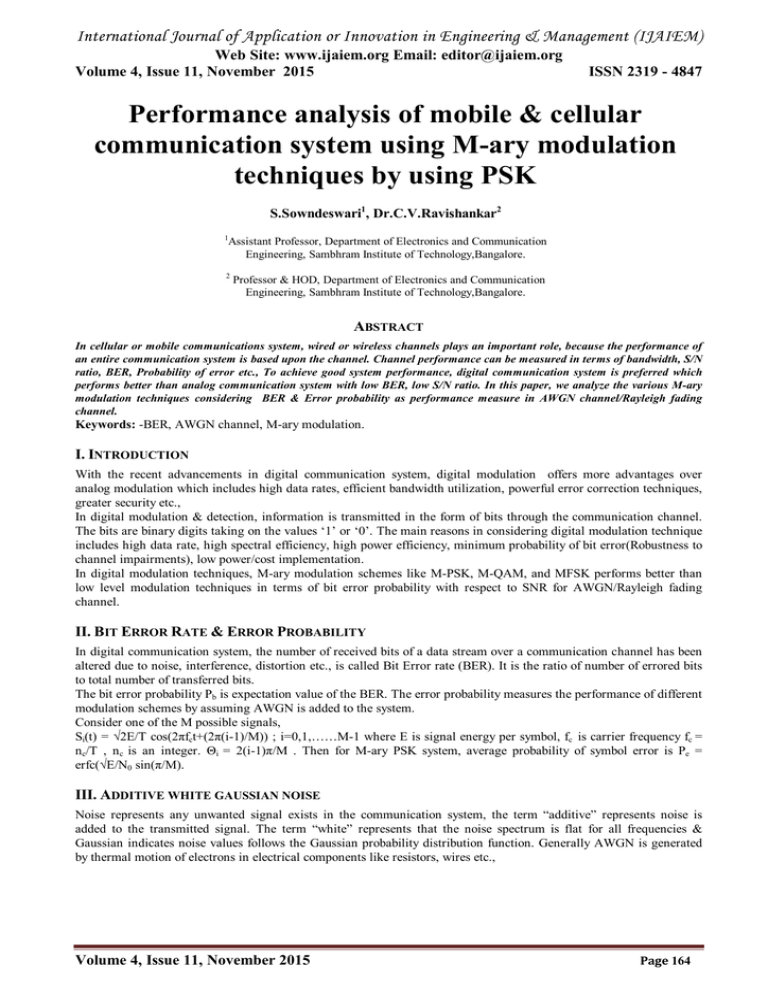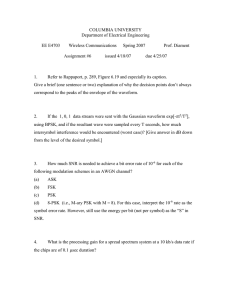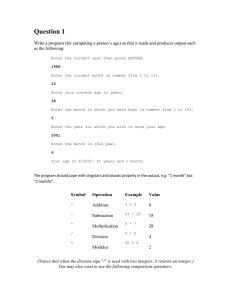International Journal of Application or Innovation in Engineering & Management... Web Site: www.ijaiem.org Email: Volume 4, Issue 11, November 2015
advertisement

International Journal of Application or Innovation in Engineering & Management (IJAIEM) Web Site: www.ijaiem.org Email: editor@ijaiem.org Volume 4, Issue 11, November 2015 ISSN 2319 - 4847 Performance analysis of mobile & cellular communication system using M-ary modulation techniques by using PSK S.Sowndeswari1, Dr.C.V.Ravishankar2 1 Assistant Professor, Department of Electronics and Communication Engineering, Sambhram Institute of Technology,Bangalore. 2 Professor & HOD, Department of Electronics and Communication Engineering, Sambhram Institute of Technology,Bangalore. ABSTRACT In cellular or mobile communications system, wired or wireless channels plays an important role, because the performance of an entire communication system is based upon the channel. Channel performance can be measured in terms of bandwidth, S/N ratio, BER, Probability of error etc., To achieve good system performance, digital communication system is preferred which performs better than analog communication system with low BER, low S/N ratio. In this paper, we analyze the various M-ary modulation techniques considering BER & Error probability as performance measure in AWGN channel/Rayleigh fading channel. Keywords: -BER, AWGN channel, M-ary modulation. I. INTRODUCTION With the recent advancements in digital communication system, digital modulation offers more advantages over analog modulation which includes high data rates, efficient bandwidth utilization, powerful error correction techniques, greater security etc., In digital modulation & detection, information is transmitted in the form of bits through the communication channel. The bits are binary digits taking on the values ‘1’ or ‘0’. The main reasons in considering digital modulation technique includes high data rate, high spectral efficiency, high power efficiency, minimum probability of bit error(Robustness to channel impairments), low power/cost implementation. In digital modulation techniques, M-ary modulation schemes like M-PSK, M-QAM, and MFSK performs better than low level modulation techniques in terms of bit error probability with respect to SNR for AWGN/Rayleigh fading channel. II. BIT ERROR RATE & ERROR PROBABILITY In digital communication system, the number of received bits of a data stream over a communication channel has been altered due to noise, interference, distortion etc., is called Bit Error rate (BER). It is the ratio of number of errored bits to total number of transferred bits. The bit error probability Pb is expectation value of the BER. The error probability measures the performance of different modulation schemes by assuming AWGN is added to the system. Consider one of the M possible signals, Si(t) = √2E/T cos(2πfct+(2π(i-1)/M)) ; i=0,1,……M-1 where E is signal energy per symbol, fc is carrier frequency fc = nc/T , nc is an integer. Θi = 2(i-1)π/M . Then for M-ary PSK system, average probability of symbol error is Pe = erfc(√E/N0 sin(π/M). III. ADDITIVE WHITE GAUSSIAN NOISE Noise represents any unwanted signal exists in the communication system, the term “additive” represents noise is added to the transmitted signal. The term “white” represents that the noise spectrum is flat for all frequencies & Gaussian indicates noise values follows the Gaussian probability distribution function. Generally AWGN is generated by thermal motion of electrons in electrical components like resistors, wires etc., Volume 4, Issue 11, November 2015 Page 164 International Journal of Application or Innovation in Engineering & Management (IJAIEM) Web Site: www.ijaiem.org Email: editor@ijaiem.org Volume 4, Issue 11, November 2015 ISSN 2319 - 4847 IV. RAYLEIGH FADING CHANNEL In wireless communication; the signal transmitted from transmitting antenna reaches the receiving antenna in multiple paths due to obstacles blocking the line-of-sight. The signal which is received along non line-of-sight path is called as Rayleigh fading channel. Error rate mainly depends upon the type of channel. V. M-ARY PSK(MPSK) Digital baseband data may be sent by varying both envelope & phase/frequency of an RF carrier wave as the envelope and phase offers two degrees of freedom and modulation techniques map baseband data into four or more possible RF carrier signals. Such modulation techniques are called M-ary modulation because they represents more signals than if just amplitude or phase/frequency are changed separately. In M-ary signaling scheme, we send one of M possible signals S1(t),S2(t)…….. SM(t) during each signaling interval of duration T. The number of possible signals are M = 2n ; n is an integer which represents number of bits in one symbol. The PSK modulated waveform can be represented as ; Si(t) = √2E/T cos(2πfct+(2π(i-1)/M)) ; i=0,1,……M-1 , where E = (log2M)Eb is the signal energy per symbol, similarly T = (log2M)Tb is symbol period. Power spectral density of M-ary PSK is SB(f) = 2PT(sin πfnT/ πfnT)2. Bandwidth of the system is equal to width of the main lobe. BW = 2fb/n. Bandwidth requirement reduces as number of bits per symbol is increased. BER of M-ary in AWGN/Rayleigh fading channel is BER 2Q 2E/N0 sin(π/M). VI. BLOCK DIAGRAM OF COMMUNICATION SYSTEM Fig.1: Communication system In the above communication system model, random integer generator generates a stream of random bits as 0 or 1. These bits are modulated by M-ary PSK modulator. The modulated signal is passed through AWGN/Rayleigh fading channel. The BER & error probability is calculated which represents the measure of performance of communication system which uses M-ary PSK modulation scheme. VII. PERFORMANCE ANALYSIS RESULTS The results of analysis of BER performance of M-ary Phase Shift Keying for M= 4, 8, 16 and 32 is obtained using MATLAB which are shown in Figure2. Eb/N0 (dB) Vs Symbol Error Rate for various M-PSK schemes 0 -1 Symbol Error Rate (Ps) -2 -3 -4 Simulated - QPSK Simulated - 8-PSK Simulated - 16-PSK Simulated - 32-PSK Theoretical - QPSK Theoretical - 8-PSK Theoretical - 16-PSK Theoretical - 32-PSK -5 -6 -7 -8 0 2 4 6 Eb/N0(dB) 8 10 12 Fig.2 Symbol error rate Vs. Eb/N0. The above graph shows symbol error rate versus Eb/N0. Symbol error rate decreases with increasing values of Eb/N0. If we don’t know the exact number of bits during transmission, then symbol error rate is obtained rather than bit error rate. Let us consider, we transmit a symbol 00 and there are some noise in the system, the detector detects the symbol as 11 instead 00. The symbol error is 1 for this case but the bit error is 2 since both of the bits in the symbol is not the correct bit. So it is advantageous to represent symbol error rate Vs. Eb/N0 than Bit error rate Vs. Eb/N0. The symbol Volume 4, Issue 11, November 2015 Page 165 International Journal of Application or Innovation in Engineering & Management (IJAIEM) Web Site: www.ijaiem.org Email: editor@ijaiem.org Volume 4, Issue 11, November 2015 ISSN 2319 - 4847 error rate can further reduced by avoiding noise added to the channel with the help of filters which is shown in the figure 3. Eb/N0 (dB) Vs Symbol Error Rate for various M-PSK schemes 0 -1 Symbol Error Rate (Ps) -2 -3 -4 -5 Simulated - QPSK Simulated - 8-PSK Simulated - 16-PSK Simulated - 32-PSK Theoretical - QPSK Theoretical - 8-PSK Theoretical - 16-PSK Theoretical - 32-PSK -6 -7 -8 -9 -10 0 2 4 6 Eb/N0(dB) 8 10 12 Figure 3. Symbol error rate Vs. Eb/N0 Comparative Analysis: Parameter Actual Value Value after reducing noise SER(QPSK) for Eb/N0 of 10 db. -5 -6 SER(8PSK) for Eb/N0 of 10 db. -3.8 -4.2 SER(16PSK) for Eb/N0 of 10 db. -1.5 -1.8 SER(32PSK) for Eb/N0 of 10 db. -0.5 -0.7 VIII. CONCLUSION M-ary modulation techniques provide better bandwidth efficiency than other low level modulation techniques. As the value of M i.e. number of bits in symbol increases bandwidth utilization is increases. In this paper, the comparison between different M-PSK (M = 4,8,16 ,32) modulation schemes in normal AWGN channel using of MATLAB is done. By analyzing the graphical representation of Eb/No Vs SER of these M-PSK schemes, we can conclude that error rate increases as the value of M increases i.e. number of bits in symbol increases, so lower level should be used for long distance communication. Also by avoiding noise added to the channel with the help of filters, error can be minimized even for high value of M. REFERENCES [1] [2] [3] [4] [5] Andrea Goldsmith, “Wireless Communications”, Cambridge University Press,2005. Behrouz Foroujan, “Data Communications & Networking”, 4th Edition, The McGraw-Hill Companies. Simon Haykin .“Communication Systems”, 4th Edition, John Willey & sons, Inc. T.S Rappaport. “Wireless Communication Principle &Practice ”, 2nd Edition, Prentice Hall, 2003. Digital Communication-Technology and Advancements, Stuti Ramola , Advance in Electronic and Electric Engineering. ISSN 2231-1297, Volume 4, Number 4 (2014), pp. 367-374. [6] Comparative Performance Analysis of M-ARY PSK Based Modulation Technique under AWGN Channel using Simulink , Aakash Agrawal, Mr J S Yadav , international journal of innovative research in electrical, electronics, instrumentation and control engineering ,Vol. 3, Issue 7, July 2015. [7] Simulink Based Comparative Analysis of M-ary Phase Shift Keying Modulation Schemes, P. Naga Malleswari, International Journal of Innovative Research in Electronics and Communications (IJIREC) Volume 2, Issue 3, May 2015, PP 9-18. Volume 4, Issue 11, November 2015 Page 166





